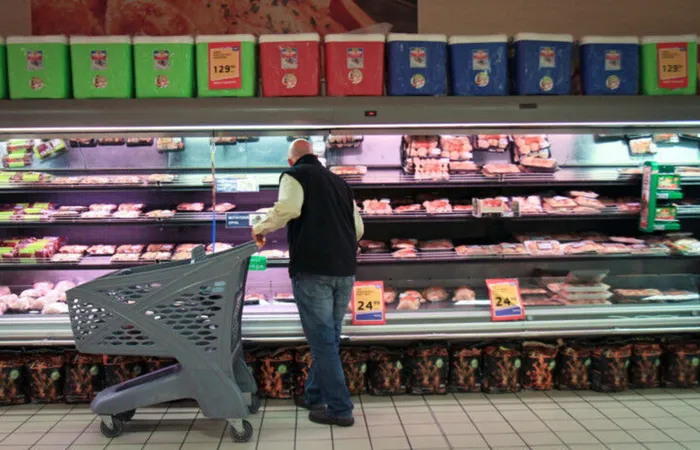Rand weakens as July inflation soars to 10-month high amid beef price surge
CONSUMER PRICES

Stats SA's chief director for price statistics, Patrick Kelly, said meat, specifically beef, remains the main driver of higher food and non-alcoholic beverage prices.
Image: File
The rand weakened to R17.70 against the US dollar on Wednesday, its lowest in more than one week, after Statistics South Africa (Stats SA) reported that consumer prices surged to their highest in 10 months in July, putting household food budgets under pressure.
Data from Stats SA on Wednesday showed that the annual headline consumer price inflation (CPI) soared from 3.0% in June to 3.5% in July, driven largely by beef prices on the back of ongoing Foot and Mouth Disease outbreak.
The July inflation print marked the second consecutive monthly increase and was the highest rate since September 2024 when it was 3.8%.
Stats SA's chief director for price statistics, Patrick Kelly, said annual inflation for food and non-alcoholic beverages (NAB) continued to rise, accelerating to 5.7% from 5.1% in June.
"Meat, vegetables and ‘other food’ fuelled the uptick. Meat, specifically beef, remains the main driver. The annual rate for meat accelerated to 10.5% in July, extending a strong upward trend that began in February," Kelly said.
"On average, beef prices increased by 28.8% over the past 12 months and by 7.6% between June and July. The average price for stewing beef was R94.80 in July 2024, climbing to R123.87 per kilogram in July 2025. Beef mince rose from R102.95 to R126.79 over the same period."
On a monthly basis, Stats SA said the CPI was 0.9% higher between June and July, mainly driven by electricity and core items.
Core inflation was 0.4% month-on-month and 3.0% year-on-year, up from 2.9% previously.
Monthly inflation of 0.6% was mainly from meat inflation and was mitigated by monthly deflation in oils and fresh produce.
Casey Sprake, economist at Anchor Capital, said meat prices, particularly beef, are under considerable strain, climbing 10.5% year-on-year in July- the steepest pace since early 2025.
"This reflects ongoing disruptions from foot-and-mouth disease (FMD), which has reduced supply and kept costs elevated," Sprake said.
"Looking ahead, further outbreaks of animal diseases, including avian flu, could prolong these price pressures well into the third quarter.
"While global supply interventions (particularly from Brazil) may help stabilise markets later in the year, the immediate risk is that persistently high food prices continue to erode the spending power of lower-income households, who spend a disproportionately larger share of their income on food."
Unisa economist Dr Eliphas Ndou said that the food and non-alcoholic beverages and the housing and utilities comprised a bigger weight in low-income households' expenditures; hence, an increase in their prices implies that low-income households' purchasing power was reduced, making them poorer.
"I hope the agricultural authorities will continue to step up their efforts to prevent foot and mouth disease from spreading and, in turn, increase the supply of meat, which would lower meat price inflation," Ndou said.
On Tuesday, the red meat industry said the shortfall in available vaccines was making it challenging to deal with the ongoing FMD outbreak.
Investec chief economist, Annabel Bishop, said the CPI was likely to rise towards 4.0% by the end of this year but then ease back down again, towards 3.5% by the middle of 2026.
"Food prices are impacted by global agricultural prices, which are priced in US dollars, and so are affected by the exchange rate, with the rand not having seen any notable gains last month or this month to date. The rand has been heavily driven by US dollar movements this year," Bishop said.
"Consumer price inflation is expected to continue to rise over the remainder of this year, with the impact of sharply falling CPI inflation in the second half of last year now coming through on the year-on-year calculation for the second half of this year, boosting the outcome."
Meanwhile, FNB senior economist Koketso Mano was forecasting headline inflation to remain flat in August, saying monthly pressure on food could continue to slow while average fuel prices should detract from monthly headline pressures.
Mano said this will be supported by muted momentum in underlying inflation.
"Therefore, we should see contained monthly pressure on the headline figure. That said, the fading of positive base effects will drive a further lift in annual inflation over the coming months," she said.
Mano said a failure by government to fully subscribe to a 3% inflation target will weaken the efficacy with which the South African Reserve Bank reduces the inflation target.
Nedbank economist Busisiwe Nkonki said the FMD in some provinces will maintain pressure on meat prices as measures to curb the outbreak are delayed by vaccine shortages, even though the upward pressure will be contained by favourable weather conditions.
"The benign inflation outlook and moderate domestic demand should provide an opportunity for further rate cuts," Nkonki said.
"However, we believe that the Monetary Policy Committee's preference for a 3% target point will tilt the decisionin favour of flat rates at the September meeting."
BUSINESS REPORT